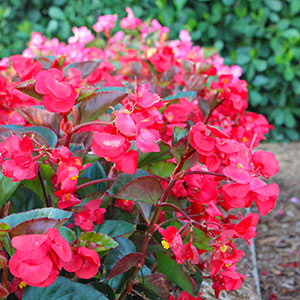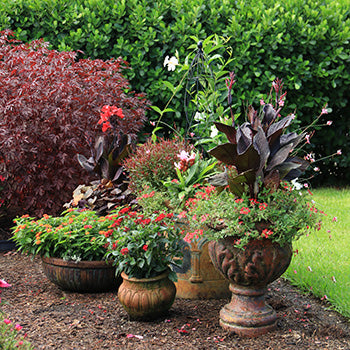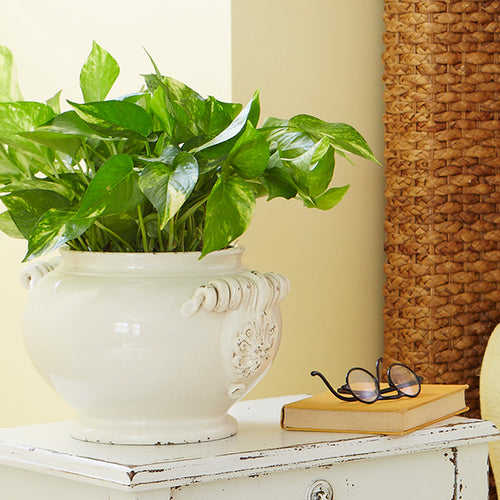Make your garden more colorful in September with these 10 tips!

1. Plant Annual Flowers
In frost-free regions, September is an ideal time to add annual flowers, such as begonia, ageratum, zinnia, and celosia, to your garden. They thrive in the mild autumn
temperatures and bloom through the early winter. Make sure to water them every day or so for the first week or two to
help get them established. Also, mulching them helps maintain
consistent soil moisture. Look for transplants with bright green leaves and thick stems. Avoid tall, leggy specimens.
Trial Garden Tip: Pair annual flowers with ornamental grasses for a spectacular effect. The blooms
of the annuals contrast nicely with the dramatic, airy seed heads of ornamental grasses.
2. Add Color with Mums and Pansies in Your September Garden
Instant impact! That’s what you’ll get when you add ready-to-bloom chrysanthemums and pansies to beds, borders, and containers. These easy-care plants relish cool weather and provide an injection of color in your September garden. Look for stocky plants that are still in bud so that you can enjoy them longer. Blooming plants are great if you need color for a same-day event, but they’re further into their bloom cycle and won’t last as long as budded specimens.Trial Garden Tip: Chrysanthemums are available in two basic types: florist and garden. Florist mums make wonderful gifts, but do not do well outside. For landscape use, look for garden mums.
- Get more on colorizing your garden with mums
- Check it out: More tips for adding late-season color to your garden
3. Improve Your Soil
Fall is a great time to improve the soil in your September garden. After you remove dead and dying vegetables and flowers, spread a 2- to 3-inch-deep layer of rotted manure or compost over the surface of the soil. Spade or rototill it into the top several inches of soil and rake smooth. If the area had been mulched previously, just spread the soil amendments over the mulch and then till everything at the same time. In smaller beds, use a garden fork to turn the soil. If you want to protect your soil from wind erosion during the winter, sow a cover crop of annual rye grass now in September. It grows quickly and keeps the soil in place until spring. By then, the grass will be dead and you can turn it under to add an extra dose of nitrogen to your soil.Trial Garden Tip: If you have a source of fresh horse or chicken manure, spread it directly over your garden in early fall. Winter snows and rains help break it down so its high nitrogen content won’t burn your crops in the spring. At other times of the year, fresh manure needs to be composted before applying.
4. Plant Spring-Flowering Bulbs
Enjoy a bounty of bloom in your garden next year by planting spring-flowering bulbs now. Tulips, daffodils, crocus, hyacinths, and other early-bird bloomers can be massed in beds by themselves or tucked in between established perennials and shrubs. Planting bulbs is easy: Just dig individual holes (8 inches deep for large bulbs like daffodils, 4 inches deep for smaller bulbs such as crocus), drop the bulb in, and cover with soil. Or, dig one large hole and toss in a dozen or more bulbs. Planted this way, they’ll pop up in one impressive drift of color.Trial Garden Tip: Select a variety of bulbs that bloom at different times to ensure color from early spring through to early summer. Some species, such as snowdrops, bloom as early as February, while late bloomers such as alliums flower in early June.
5. Clean Up Vegetable Gardens
The best way to prevent insects and diseases from affecting your vegetable garden next year is to clean it up this fall. Always remove rotting fruit, diseased foliage, or dead vines as soon as they appear. This is especially true with crops such as tomatoes, potatoes, melons, and squash. Pests and diseases love to overwinter on these vegetables if they are left in the garden to rot. Compost your garden refuse as soon as possible and, if your crops have been ill over the summer, consider burning the remains or bagging them for garbage pick-up.Trial Garden Tip: Make sure any leaves or tendrils are cleaned off tomato cages and supports before you store them for the winter. It only takes one insect egg case or spore clinging to the support to cause havoc in your garden next spring.
6. Bring Houseplants Indoors
If you haven’t done so already, bring vacationing houseplants indoors before frost. Give each plant a cleansing spray from the garden hose, then inspect them closely for insect hitchhikers hiding in the foliage. Wipe the pots clean to remove any soil that may have splashed up on them during the summer. Let them dry and then carry them into the house placing them on saucers to protect your floors from runoff. Some plants may also have put on a lot of new growth over the summer and will require a bit of pruning to shape them up before you bring them inside.Trial Garden Tip: To prevent unexpected soil pests from moving indoors, sink each pot in a bucket of water for a few hours before bringing the plant indoors. This process drowns or uncovers any slugs, snails, worms, or beetles hiding below the surface of the soil.
Get tips for bringing your tropicals inside.
7. Enhance your Landscape
September is an ideal time to add shrubs and trees to your landscape. Hydrangeas, roses, and other flowering shrubs and trees flourish during the cool, moist fall weather. Just be sure to do a little research before you add any plants to your landscape: Look for varieties that are hardy in your climate and won’t grow too large for the space you have. And always remember that even the smallest sapling will eventually grow into a tree that could swallow your home if planted too close.Trial Garden Tip: Improve winter survival of trees and shrubs by watering them deeply right up until hard frost. The soil should be moist before it freezes solid.
8. Improve Your Lawn
Give your lawn some attention this month. Most cool-season lawns benefit from dethatching, aeration, and fertilization. You can also seed or sod new lawns at this time or fix bare spots in older lawns. It’s also the season to control perennial weeds such as clover and dandelion. In the fall, these weeds prepare for winter by pulling nutrients and starches from their leaves into their roots. When you apply a lawn herbicide in the fall, the plants will also draw the chemical into their roots and die. Southern grasses such as bahia, Bermudagrass, zoysia, and St. Augustine can also be fertilized this month. Choose a fertilizer that contains controlled-release nitrogen that will feed the turf as it needs it.Trial Garden Tip: There’s no need to purchase lawn tools such as aerators, dethatchers, or rototillers: They are all available to rent at your local home store.
9. Dry Flowers
Savor the colors of your September garden all winter long by creating dried bouquets of your favorite flowers. Strawflower, globe amaranth, celosia, sedum, statice, yarrow, and artemisia are just a few examples of flowers that are easy to dry and preserve beautifully for winter bouquets. Just cut the blooms (leaving as long a stem as possible) in the morning after the dew evaporates. Bundle them, and hang them upside down in a dry, well-ventilated, dark location. After a week or two they can be taken down and mixed together to create everlasting bouquets or wreaths.Trial Garden Tip: Use a piece of foam core at the bottom of your vase to keep dried flowers in place. Just stick each stem into the foam base for stability.
10. Engage a Kid
Now that school is back in session, engage the budding scientist in your life with a terrarium project. Terrariums are fun and allow children to create a miniature world all their own. Plus, kids learn valuable lessons about how soil, plants, water, and air interact in a perfect environment. They can even choose between a jungle or desert themes.Jungle-theme terrariums can include plants such as peperomia, pilea, ferns, nerve plant, selaginella, begonia, philodendron, and saxifrage. In a desert garden, try mammillaria, echeveria, sempervivum, portulacaria, crassula, kalanchoe, sedum, and haworthia.
Trial Garden Tip: Any glass container can be transformed into a jungle terrarium. Avoid the urge to water too frequently: Misting your plants once a day provides needed humidity without flooding the container. Dish gardens planted with desert plants should only be lightly watered once or twice a month.
Fall Gardening Questions?
We love to talk to other gardeners. Email us your questions and we'll have one of our experts get back to you!

















